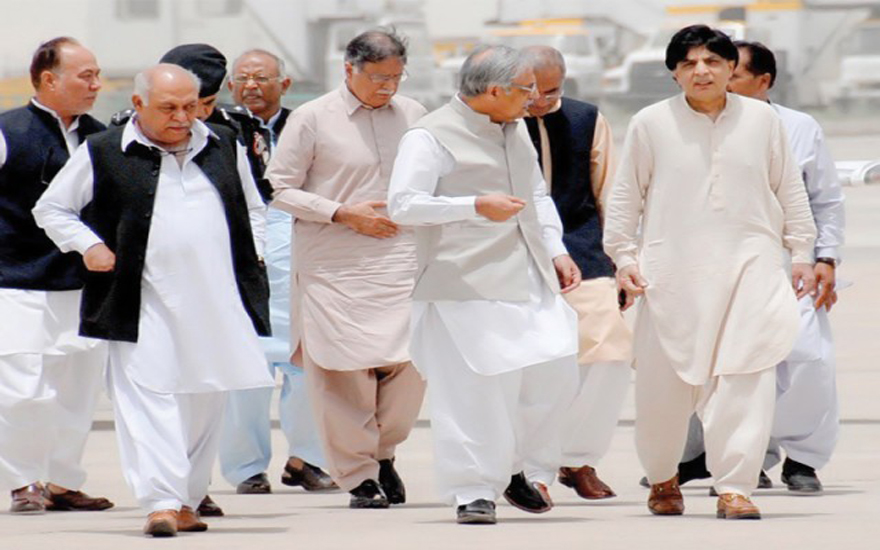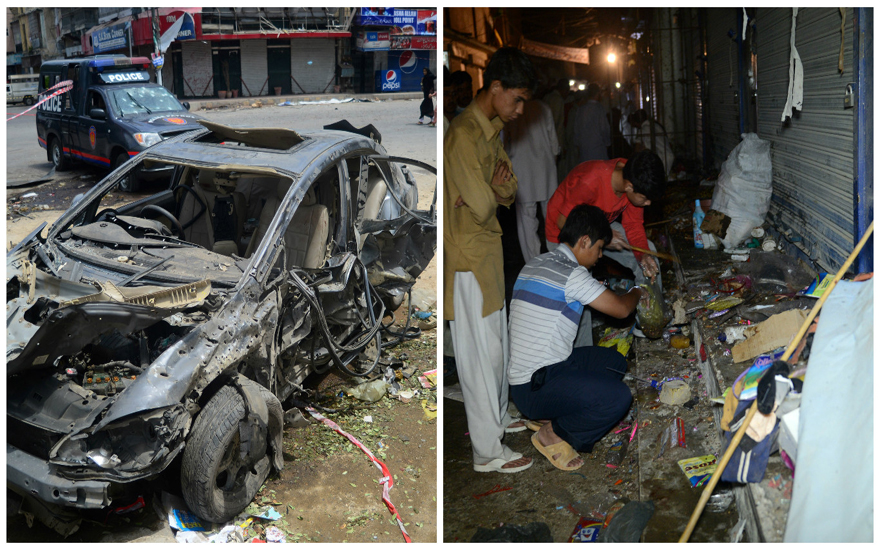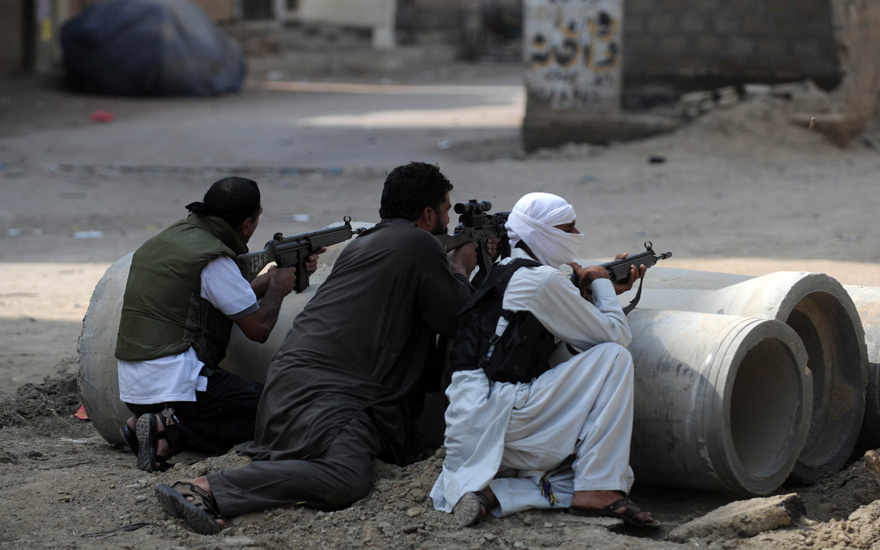United They Stand
By Syed Talat Hussain | Cover Story | Published 12 years ago
A united front of terrorists (UFT) has emerged in Pakistan transmuting a chronic but hitherto fragmented danger into an existential multi-layered threat. From Khyber to Karachi to Quetta, a ring of terrorists of different hues has formed a network that senior military officials describe as a mini-Al-Qaeda, whose strategy is to attack the state and terrorise the population. The aim is to strain financial resources, retard efforts at economic revival and, worse, kill hope that Pakistan’s recent elections had bred about the country’s future.
It is not a mystery as to who these groups are. The list contains familiar names, although there have been some new entrants as well whose role is more of facilitators and enablers rather than deliberate players in coordinating crimes against the state. Sectarian outfits top the list; next come the so-called separatists in Balochistan; remains of Al-Qaeda are another element; the Taliban, entrenched in North Waziristan but beaten badly and uprooted from other hideouts in Khyber Agency’s Tirah valley bordering Afghanistan’s famous Tora Bora mountains, have become doubly dangerous; Karachi’s political gangs whose internal fights have made them seek the terrorists’ help to wreak local havoc are also in the fray; and of course there are the criminal syndicates involving kidnappers-for-ransom, timber mafias and car-jackers whose business thrives only in chaos and in a state that has lost control over parts of its territory.
This new-found unity among the terrorists is not so much in their command as in their actions and sharing of resources. Military officers point out that in several incidents, including those in Quetta where Hazaras were attacked and before that the brutal massacre of female medical students, while the planning and execution was done by one sectarian outfit, material to carry out the attacks and communication was provided by the Taliban. Senior bureaucrats in Balochistan, in detailed background briefings, have gone as far as to say that suicide bombers have actually been purchased in some of these incidents from FATA. In the incident of burning of the Quaid-e-Azam’s residency in Ziarat, the coordination was done by groups located in Kandahar, Afghanistan.
“We are seeing a new universe of terrorism being formed right before our eyes. It has different planets, satellites, asteroids, comets etc., but they all move around in the same orbit of waging a war against Pakistan,” said an official from the interior ministry who acknowledged that his analogy was needlessly romantic in describing a bloody threat whose human and material toll has escalated to mind-boggling proportions.
The most commonly shared resource among UFT is intelligence information about the movement of convoys or individual targets through a networking system that involves various local cells. “The new volunteerism shown by some of these groups, who had previously been at each other’s throats, in marking the target is remarkable. Groups actually send invitations to others to take out a target in case they do not have the capacity to perform the heinous act themselves,” says a senior official of the ministry of interior. “We are seeing a new universe of terrorism being formed right before our eyes. It has different planets, satellites, asteroids, comets etc. but they all move around in the same orbit of waging a war against Pakistan,” said the official who acknowledged that his analogy was needlessly romantic in describing a bloody threat whose human and material toll has escalated to mind-boggling proportions. In Karachi alone, since the May elections the ratio of those killed in violence is almost a 100 per cent more than the average before elections. In terms of frequency of incidents the same timeframe has proven to be far deadlier than the period before the elections.
But if the analogy must be kept for a systematic explanation of this new face of terrorism in the country, then two most important questions have to be raised: Who is the central star of this solar system of slayers? And secondly, what has caused different groups to begin to join hands or at least coordinate actions? The second question is answered differently in various official quarters, while on the first there is no clarity — no one is able to name a single mastermind behind these attacks. These groups continue to exist as separate entities with their own command structure but there is great cohesion and alignment in their activities, claim senior intelligence sources.
The military and the intelligence sources in different briefings to Newsline, have indicated that in certain cases this coordination is planned outside Pakistan by the Kabul-Delhi combine and executed inside the country in large measure by Pakistani Taliban groups hit hard by recent military operations. In Balochistan, the complexity of this nexus of foreign forces with local groups, according to these sources, can be gauged from the fact that fragments of sectarian groups headed by local Baloch — itself a novelty as Baloch have no history of religious leanings of the extreme variety — who previously were fighting Baloch separatists are now known to be facilitating some of their former opponents’ operations. This is so because now they both see law enforcement agencies as a far bigger threat than each other’s leanings.
Similarly, Karachi’s political fragmentation has led some militant wings of political parties to arrange resources for the same Taliban groups that they had been ideologically opposed to. “This is too complicated to have happened without a mentor and, on the basis of information available with us, we believe that the epicenter of this planning is across the border,” says a high-ranking intelligence official. However, this assessment seems overly simplistic and quite cliched considering that no government in Pakistan has ever brought into the open evidence that could firmly establish foreign sponsorship. The previous government had, on occasions, held in-camera briefings for parliamentarians by top military and intelligence officers, which included oral testimonies and power-point presentations regarding the involvement of the foreign hand, but even these proved to be insufficient to convince the law-makers about the causes of the breakdown of law and order. The notion of “connivance or incompetence” remains popular among members of the new assembly. Mehmood Khan Achakzai, head of the Pakhtoonkhwa Milli Awami Party, whose brother is the governor of Balochistan, angered many in Pakistan’s powerful establishment when, in assessing his province’s precarious law and order situation he alluded to the role of intelligence agencies in fomenting trouble. He caused such a stir that the office of the prime minister of Pakistan had to step in to settle the issue.

Fighting shadows: Interior Minister Chaudhary Nisar Ali Khan (far right) meets with tBaloch leaders after the Quetta bombings.
Political sources in the prime minister’s secretariat, however, insist that this time the foreign component of the reign of terror in Pakistan is well-documented. “We have handed over evidence of some of the incidents in Balochistan directly to the US because the planning was done in Afghanistan,” claims a senior civil bureaucrat. However, he agreed with the analysis that for the most part, terrorism remains a local problem requiring action on native ground. This action, however, becomes tricky when local politics is mixed with local terrorism.
Intelligence officials draw a distinction between high-grade terrorism and low-intensity yet dangerous local conflict whose roots are more political than strategic. “Some of Karachi’s killings are primarily related to the internal upheaval the MQM is currently undergoing. The party’s politics is in a mess. Others are gang wars for turf and control of neighbourhoods. In this chaos a very weak administration has only aggravated the situation. Taliban groups and outside forces obviously see this as a godsend and they have plans to bring big-ticket terrorism to Karachi as well,” says the same source. These are broad-spectrum statements and furnish a poor basis for determined action on ground. Intelligence sources admit that the scope of action against terrorism is reduced by the nature and direction of politics in the provinces. “In Sindh no one is in charge and, therefore, everyone is in charge.
In Balochistan the government is still trying to find its way forward, while terrorists are highly motivated and have a clear idea about their targets. In KPK, the ruling coalition’s idea of peace talks and appeasement has undermined any swift administrative action. As for Punjab, without the other three provinces on the same page, its efforts cannot create a national level counter-terrorism impact,” says a frustrated member of premier Sharif’s core political team.
Counter-terrorism efforts require daily interaction, close cooperation and ongoing meetings among the principal decision-makers. This smart on-the-go arrangement does not exist. Instead, an informal kitchen group operates on a need-to-meet basis. This generally involves the chief of army staff, the Punjab chief minister, the interior minister and, occasionally, the principal secretary to the prime minister. However, the decisions of this group are not formal and nor is any detailed record (notes) of these meetings kept. They all come together more for consultation rather than policy-making. Once out of the room, they all go back to their respective fields where other issues compete for their attention and time. Terrorists, on the contrary, are getting more agile, more frustrated and more communicative with each other.
This presents a nightmare scenario for the newly-installed government of Mian Nawaz Sharif. His interior minister, Chaudhary Nisar Ali Khan, is poring over different drafts of “an integrated national security policy.” Those in the prime minister’s secretariat who have seen some of these drafts say that this is probably the first time that a genuinely integrated approach to matters of national security has been adopted. This approach seeks to combine intelligence-sharing, actionable intelligence dissemination and execution of aims by a national security policy apparatus under the command of the interior minister supervised directly by the prime minister.
Since all terrorism has a foreign connection, one way or the other, therefore all institutions will be associated with this process of setting targets and achieving results. From policy reform to disinfecting the jails, from sorting out the stalled prosecution system to invigorating the legal regime governing counter-terrorism efforts, the proposed national security policy throws its net wide in the hope of stabilising the country internally.
These sources suggest that a more “broad-based decision-making process” will be the centerpiece of this new national security policy. However, they duck the million-dollar question about the institutional mechanism that would underpin this broad-based consultation (implying civil and the military leaders sitting under one roof focused on one task). They say that the cabinet committee on defence chaired by the prime minister is the main forum. However, this excludes the president, who even after the 18th Amendment, has jurisdiction over FATA. Moreover, the same constitutional amendment also devolves all law and order responsibility to the provinces without whose consent the centre cannot make any move to restore law and order, unless of course governor’s rule is imposed, thus granting the centre jurisdiction for action.
Also the defence committee of the cabinet is too large and wobbly. Its sessions cannot be held every day. Counter-terrorism efforts, however, require daily interaction, close cooperation and ongoing meetings among the principal decision-makers. This smart on-the-go arrangement does not exist. Instead, an informal kitchen group operates on a need-to-meet basis. This generally involves the chief of army staff, the Punjab chief minister, the interior minister and, occasionally, the principal secretary to the prime minister. However, the decisions of this group are not formal and nor is any detailed record (notes) of these meetings kept. They all come together more for consultation rather than policy-making. Once out of the room, they all go back to their respective fields where other issues compete for their attention and time.
Terrorists, on the contrary, are getting more agile, more frustrated, more communicative with each other and if the foreign backing allegation is true, are also getting groomed in new ways on how to use minimum effort for maximum terrorism impact. To deal with this elusive enemy would require not just rhetoric but totality of combined action. Right now, as Pakistan witnesses a spiral of violence gripping its main cities, that type of action is missing. The storm has arrived and is sweeping across the country. As for the shelter, well, it is still work in progress. No one in the government wants to commit to a date by which it will be ready and effectively in operation.
The writer is former executive editor of The News and a senior journalist with Geo TV hosting a prime time current affairs program.





